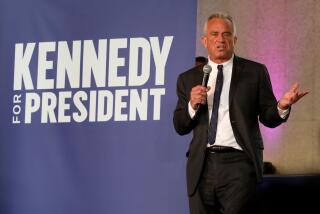Malignancy Removed From Casey’s Brain
- Share via
WASHINGTON — Surgeons Thursday removed what they identified as a relatively rare type of cancerous tumor from the brain of 73-year-old CIA Director William J. Casey.
In a written statement, officials at Georgetown University Hospital said that the nearly 5 1/2-hour operation proceeded without complications and described the intelligence chief as “in stable condition and doing well.”
The statement said that the tumor, identified on preliminary examination as a lymphoma, “appears treatable” and predicted that Casey would be able to resume “normal activities” after recovering from the surgery.
Guarded Prognosis
Medical specialists agreed that, if a final pathology report confirms the lymphoma diagnosis, Casey is likely to respond well to treatment initially. But they said the longer-term prognosis is more guarded because lymphomas have a tendency to recur.
Dr. Eugene Stern, a neurosurgeon and chairman of the department of surgery at UCLA Medical Center, said of lymphomas in the brain: “Often, it’s hard to arrest their progress. They are sensitive to radiation therapy, but usually only temporarily. These tumors tend to have a guarded outlook in the long pull, but treatment is available.”
As a result, Reagan Administra tion sources said that it is highly uncertain whether Casey will return to his position as the nation’s highest-ranking intelligence officer.
Three surgeons excised the tumor from the inner side of the left half of Casey’s brain, an area controlling motion and sensation on the body’s right side, according to the hospital statement, but they did not comment on what if any physical impairment Casey will suffer. The operation lasted from 7:40 a.m. to 1 p.m.
The White House afterward issued a statement saying that President Reagan and his wife, Nancy, were “deeply distressed and concerned.” Reagan called Casey “a talented, dedicated and able public servant whose service to this Administration and to our country is deeply valued.” And he added: “Our thoughts and prayers are with Bill and his family.”
The surgery on Casey, the President’s close friend, political adviser and intelligence chief for nearly six years, came four days after he suffered leg and arm seizures in the CIA’s McLean, Va., headquarters and was taken by ambulance to Georgetown University hospital, where a second seizure occurred while he was under examination.
Scheduled to Testify
Casey was struck down the day before he was scheduled to testify to the Senate Intelligence Committee about the Iran- contras scandal, after testifying about the matter twice last week before the House Intelligence Committee.
A CIA spokesman said then that the seizures might have been connected to a recent change in medication that he said Casey receives for high blood pressure. But an Administration source said Wednesday that Casey had “had indications that something wasn’t (physically) right” several days earlier and had shrugged them off, only to suffer the new seizures Monday.
The tumor apparently was discovered Wednesday after Casey underwent a computer-aided tomography, or CAT, scan of his head and surgery was ordered immediately.
Top White House and CIA officials learned of the growth Wednesday. CIA Deputy Director Robert M. Gates, the man ordinarily in charge of the agency’s day-to-day operations, has taken over Casey’s duties during his hospitalization and is a top candidate to succeed Casey, should he not return to the job.
The kind of neurosurgery Casey underwent is almost certain to have a seriously weakening impact on a man of his age. And a course of further treatment--probably involving radiation--will likely be prescribed after his doctors have completed a detailed study of his case, medical specialists said.
Pressured to Resign
Moreover, the malignancy was discovered at a time when both Casey and the CIA are mired in the worst intelligence bureaucracy crisis since the Watergate years. Casey has come under pressure from congressional critics to resign.
Lawmakers questioned the CIA director last week about his knowledge of the secret cash-skimming operation that diverted millions of dollars in profits from Iranian arms sales to rebels battling Nicaragua’s Sandinista government. Casey has denied learning of the scheme until October but news reports have alleged that he had earlier and still-unrevealed links to the affair.
He also has come under questioning for the CIA’s decision to provide support for a November, 1985, arms shipment to Iran without first obtaining written authorization from the President.
Given all these problems, one knowledgeable official said, it is regarded within the Administration as almost certain that Casey will not resume his former responsibilities.
Lymphomas, cancers of the net-like lymphatic tissues that help maintain the fluid environment throughout the body, are very rare in the brain and often difficult to treat, according to neurosurgeons interviewed Thursday by The Times.
Difficult to Remove
“In the brain, their behavior is difficult, because you can’t always remove them fully,” said Dr. Michael Walker, head of the stroke and trauma division of the federal government’s National Institute of Neurological and Communicative Disorders and Stroke. “Often, there is microscopic tumor left. It responds successfully to radiation and chemotherapy, but, by and large, these kinds of tumors often recur some time in the future.”
Georgetown hospital did not say whether Casey’s tumor was a primary tumor--that is, one that originated in the brain--or a secondary tumor that had spread from elsewhere in his body. “It’s extremely important from the point of view of his future therapy to know whether he has lymphoma elsewhere, as well as in his brain, or whether it is confined solely to his brain,” Walker said. “A primary lymphoma is rare.”
But Dr. Fred Hochberg, associate professor of neurology at Harvard Medical School and a neurologist at Massachusetts General Hospital, said that most secondary lymphomas are discovered “in the spinal fluid or pressing on the spinal cord” rather than in the brain itself, where Casey’s was situated.
“It is extremely rare to see a lymphoma in the brain substance that comes from elsewhere in the body,” he said.
Hochberg, who has been studying brain lymphomas, said that before 1972, such tumors occurred with a frequency at Massachusetts General Hospital of less than one case every two years. Since then, he said, there has been a fivefold increase, “the only such brain tumor which has undergone such a dramatic increase.”
Connected to Disorders
Brain lymphomas are often seen in individuals with depressed immune systems, such as organ transplant recipients and AIDS patients, and in people with certain specific disorders involving cell regulation and the inability to fight infections, Hochberg said. Also, he said, there appears to be a connection between primary brain lymphomas and the virus responsible for infectious mononucleosis.
A final pathology report on the tumor is expected next week. The Georgetown hospital statement said: “There will be no further medical details available on Mr. Casey before the test results are final. The length of his hospitalization will be determined at that time.”
Before the hospital announcement was made, White House spokesman Rusty Brashear said there was “deep concern” about Casey and that Reagan had inquired about the CIA director’s health, although the President had not spoken with him since he entered the hospital. He also said that Vice President George Bush visited Casey Wednesday.
Senate Intelligence Committee Chairman Dave Durenberger (R-Minn.) called the developments in Casey’s medical situation the “most regrettable, and hopefully not tragic,” part of the day’s events. He said that Casey has a “very special loyalty to his country” and is a “very special person,” adding: “We feel very deeply for Bill and his family at this time.”
Casey, 73, a crusty veteran of World War II intelligence operations, has won generally positive marks during his six years as the nation’s top spymaster. Many experts say that he rallied to its old levels of confidence and ability an intelligence community that had been shattered by the Watergate scandal and the legal constraints on espionage activity that followed.
Criticized on Leadership
At the same time, critics contend that Casey has resurrected the more free-wheeling and secrecy-obsessed traits that marked the U.S. intelligence community during the early postwar years, and that the Iran affair may stem in part from the CIA’s renewed willingness to take high-stakes gambles.
Casey has been director of central intelligence since Reagan took office in 1981, occupying a post that includes leadership of the CIA and overall responsibility for more than a dozen large and small intelligence organizations that make up the government’s intelligence community.
The most important of these are the CIA and National Security Agency but they include offices within the Justice, Treasury, Energy and Defense departments as well.
Casey served with the CIA’s forerunner, the Office of Strategic Services, during World War II. During the Richard M. Nixon Administration, he was chairman of the Securities and Exchange Commission. In 1980, he was chairman of Reagan’s presidential campaign.
Gates, the CIA’s interim director, is 42 and has been Casey’s second in command for nine months. He had headed the agency’s analytic division and earlier served on the Jimmy Carter Administration’s National Security Council staff.
Frank C. Carlucci, Reagan’s new national security adviser, was CIA deputy director in the Carter Administration and knows Gates. Other possible candidates for the intelligence job, should Casey be unable to return, include Lt. Gen. William Odom, director of the National Security Agency, the chief U.S. code-breaking and electronic-eavesdropping agency.
Outside the government, former Tennessee Sen. Howard H. Baker Jr. has been mentioned as a possible Casey successor, if Baker decides not to seek the presidency in 1988. Also mentioned is Don Rice, president of the Rand Corp. of Santa Monica.
Staff writers Maura Dolan, James Gerstenzang and Robert C. Toth also contributed to this story.
More to Read
Sign up for Essential California
The most important California stories and recommendations in your inbox every morning.
You may occasionally receive promotional content from the Los Angeles Times.










